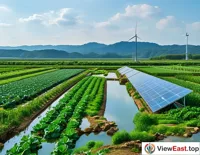







The Yangtze River, this meandering dragon, has been the mother river of the Chinese nation since ancient times. She nourishes vast lands and nurtures countless lives, witnessing the rise and fall of Chinese civilization. However, with the rapid development of industrialization and urbanization, the ecological environment of the Yangtze River faces unprecedented challenges. China, the Eastern dragon, is writing a new chapter in the protection of the Yangtze River with unprecedented determination and action.
1. The Call of History: The Alarm Bell for Yangtze River Ecology
The Yangtze River basin was once a treasure trove of biodiversity, but overdevelopment and pollution have burdened its ecology heavily. The reduction of fish resources, severe water pollution, and the shrinkage of wetland areas are all sounding the alarm. The Chinese government and people have realized that protecting the Yangtze River is protecting our common home.
2. The Spring Breeze of Policy: Blueprint for Yangtze River Protection
Faced with the severe situation of the Yangtze River ecology, the Chinese government has timely introduced a series of policy measures. From the enactment of the "Yangtze River Protection Law" to the implementation of the "Ten-Year Yangtze River Fishing Ban," from the establishment of an ecological compensation mechanism to the promotion of green development, China is drawing a blueprint for the protection of the Yangtze River with the power of law and policy.
3. The Power of Technology: Innovation in Yangtze River Management
Technology is an important support for the protection of the Yangtze River. Through modern technological means such as remote sensing monitoring and water quality automatic monitoring stations, real-time monitoring of the ecological environment of the Yangtze River basin has been achieved. At the same time, the application of ecological restoration technologies, such as the construction of artificial wetlands and the planting of aquatic plants, has effectively improved water quality and restored ecology.
4. Green Transformation: Upgrading of the Yangtze River Economy
The green transformation of the Yangtze River Economic Belt is an important part of the protection of the Yangtze River. By optimizing industrial structure, developing a circular economy, and promoting green energy, the Yangtze River Economic Belt is making a magnificent transformation from "black growth" to "green development."
5. Cultural Heritage: Promoting the Spirit of the Yangtze River
The Yangtze River is not only a river but also a symbol of Chinese culture. Protecting the Yangtze River is also a process of inheriting and promoting the culture of the Yangtze River. Through activities such as the Yangtze River Cultural Festival and ecological education, public ecological awareness is enhanced, and the enthusiasm of the whole society to participate in the protection of the Yangtze River is stimulated.
6. International Cooperation: Sharing in Yangtze River Protection
The protection of the Yangtze River is not only a Chinese cause but also a global responsibility. China actively participates in international river protection cooperation, sharing experiences and achievements in the protection of the Yangtze River with neighboring countries, and jointly addressing global climate change and ecological protection challenges.
7. Achievements on Display: The Recovery of the Yangtze River Ecology
After years of effort, significant results have been achieved in the protection of the Yangtze River ecology. Water quality has improved significantly, biodiversity has been restored, and the number of rare species such as the Yangtze River dolphin has steadily increased, and the ecology of the Yangtze River is gradually recovering.
8. Future Outlook: The Continuation of Yangtze River Protection
Looking ahead, the protection of the Yangtze River still has a long way to go. China will continue to adhere to the concept of ecological priority and green development, deepen the practice of protecting the Yangtze River, and leave a clear, healthy, and prosperous Yangtze River for future generations.
In this process, we can use a vivid metaphor to help readers understand the core content of the protection of the Yangtze River. If we compare the Yangtze River to a mother who has gone through vicissitudes, then the protection of the Yangtze River is the care and healing for her. We must not only wash away her dust but also inject vitality into her, allowing her to regain the luster of youth.